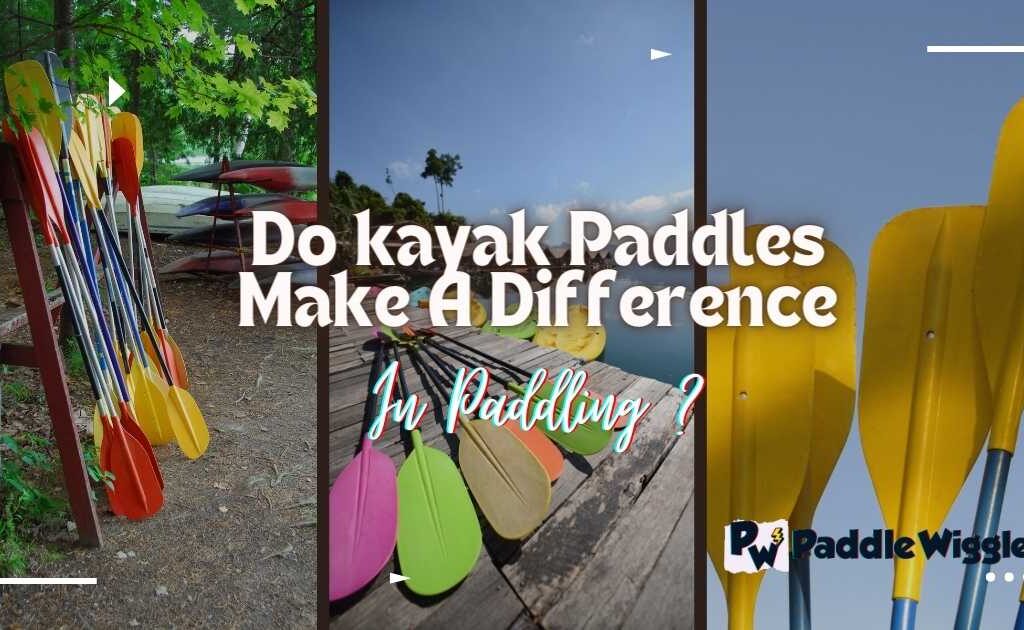Rowing and kayaking are fantastic ways to exercise and enjoy the outdoors. But when it comes to choosing between a row boat and a kayak for your water adventure, things can get a bit tricky.
So, which one should you go for—rowing or kayaking? Well, they each offer a unique experience, and the choice depends on what you like and what kind of adventure you want. But here’s the deal: they’re quite different in how you do them.
Rowing means using oars to move a rowboat. It works your upper body and needs good coordination. Kayaking, on the other hand, is about using a double-bladed paddle in a small, narrow boat. This makes kayaks super maneuverable.
If you’re new to all of this, don’t worry. In this comparison, we’ll go through all the differences between row boats and kayaks so you can make a smart choice. By the end, you’ll know which one suits your adventure goals better.
So, let’s dive in and explore the world of rowing versus kayaking—it’s going to be a fun ride!
Contents
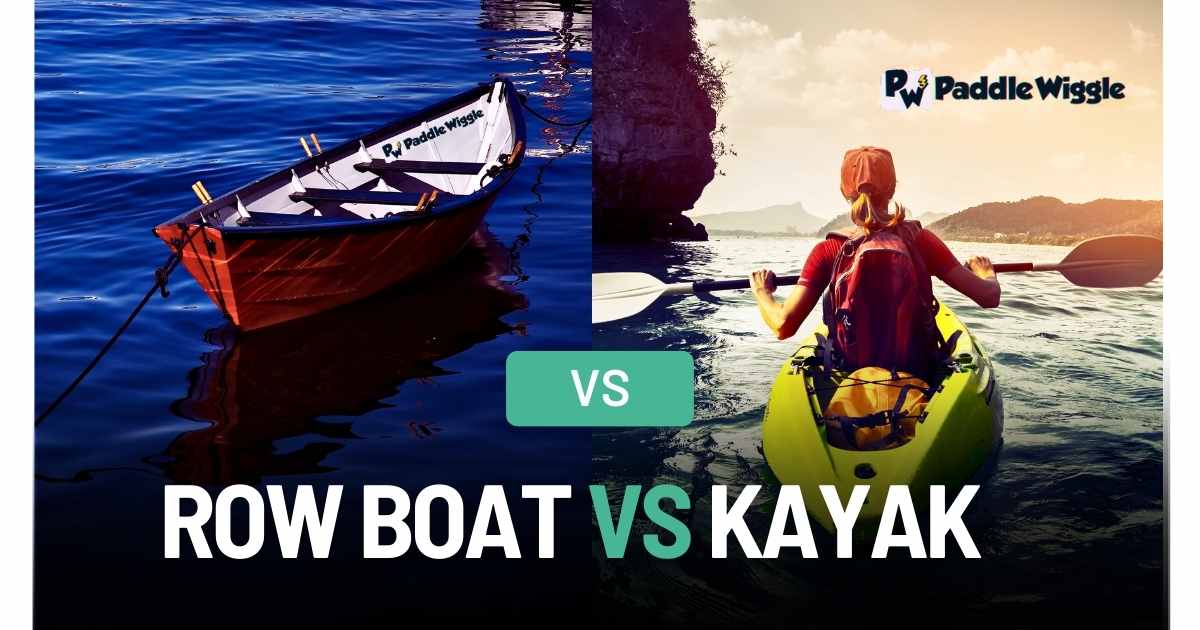

Rowing And Kayaking
Rowing and kayaking are both activities that involve propelling a boat through water using oars or paddles. These water sports not only provide a great cardiovascular workout but also offer opportunities for recreational or competitive purposes.
Whether you prefer the tranquility of rowing or the thrill of kayaking, both activities allow you to enjoy nature while engaging in physical exercise.
Cardiovascular Workout
Both rowing and kayaking are excellent forms of exercise that get your heart pumping and your muscles working. When you row a boat, you use rowing oars to push against the water, which engages your upper body, core muscles, and legs. This full-body workout helps improve strength, endurance, and overall fitness.
On the other hand, kayaking involves paddling strokes with a kayak paddle to maneuver through the water. The repetitive motion of paddling targets your arms, shoulders, back muscles, and core. Both activities provide an effective cardiovascular workout that can help improve stamina and burn calories.
Recreational Paddling
For those who enjoy leisurely activities on the water, both rowing and kayaking offer opportunities for recreational paddling. Rowing boats are typically larger in size compared to kayaks and can accommodate multiple people comfortably. They are often used for gentle cruises along calm lakes or rivers, allowing you to relax while taking in the scenic views around you.
Kayaks come in various types, such as touring kayaks or inflatable kayaks designed specifically for recreational purposes. They offer more maneuverability than rowboats due to their smaller size and single-person capacity. With a kayak, you can explore narrow waterways like creeks or navigate through marshes where larger boats may struggle to reach.
Competitive Pursuits
Aside from recreational paddling, both rowing and kayaking also have competitive aspects that attract athletes looking for a challenge. Rowing is commonly practiced as a team sport, with rowers working together to propel the boat forward as efficiently as possible. Competitive rowing events range from regattas held on calm waters to thrilling races in open seas or rivers.
Kayaking, on the other hand, offers various competitive disciplines, such as whitewater kayaking or sprint kayaking. Whitewater kayakers navigate through fast-moving rapids and challenging obstacles, showcasing their skills in maneuvering and balancing. Sprint kayakers participate in races where speed and agility are crucial factors for success.
Comparing Row Boat Vs. Kayak
Rowboats and kayaks are two popular types of watercraft that offer different experiences on the water. Let’s take a closer look at the differences between row boats and kayaks to help you decide which one suits your needs.
Row Boats: Larger, Wider, And Heavier
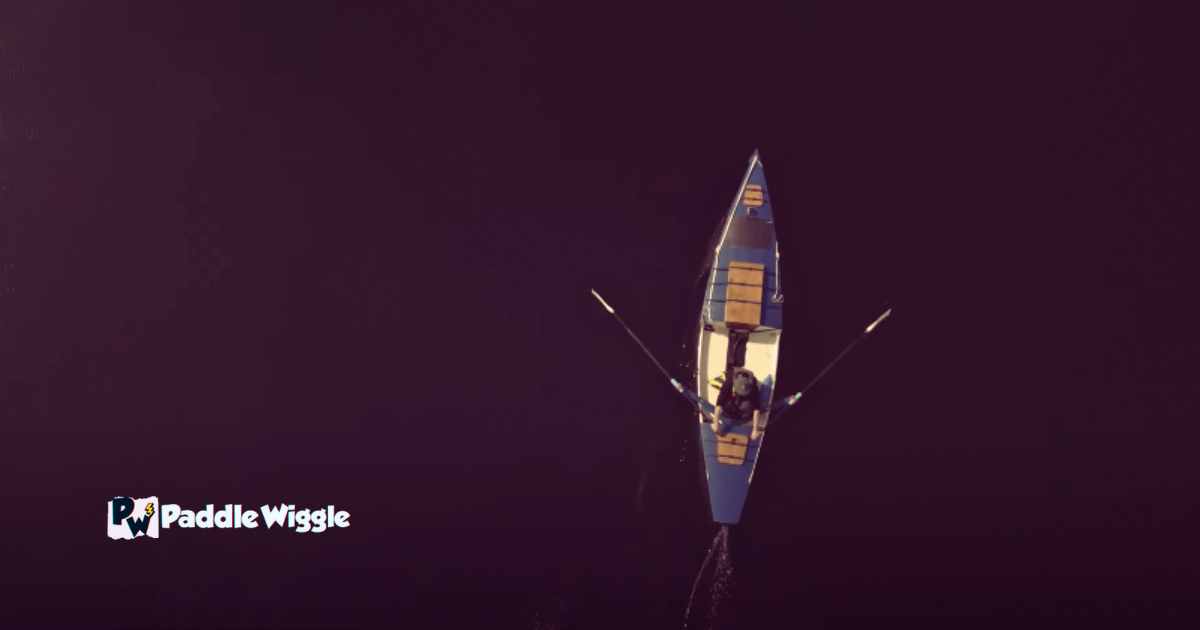

Rowboats are known for their larger size, wider hulls, and heavier build compared to kayaks. These characteristics make row boats more stable in the water, allowing for a smoother ride. The larger size also means that row boats can accommodate more people or gear, making them suitable for activities like fishing or leisurely cruises.
Pros of Row Boats:
- Stability: The wider hull provides better stability in rough waters.
- Capacity: With more space, row boats can carry multiple passengers or equipment.
- Versatility: They are suitable for various activities such as fishing or picnicking.
Cons of Row Boats:
- Maneuverability: Due to their larger size and weight, row boats may be harder to maneuver in tight spaces or narrow waterways.
- Speed: Rowboats tend to be slower compared to kayaks due to their bulkier design.
Kayaks: Smaller, Narrower, And More Maneuverable
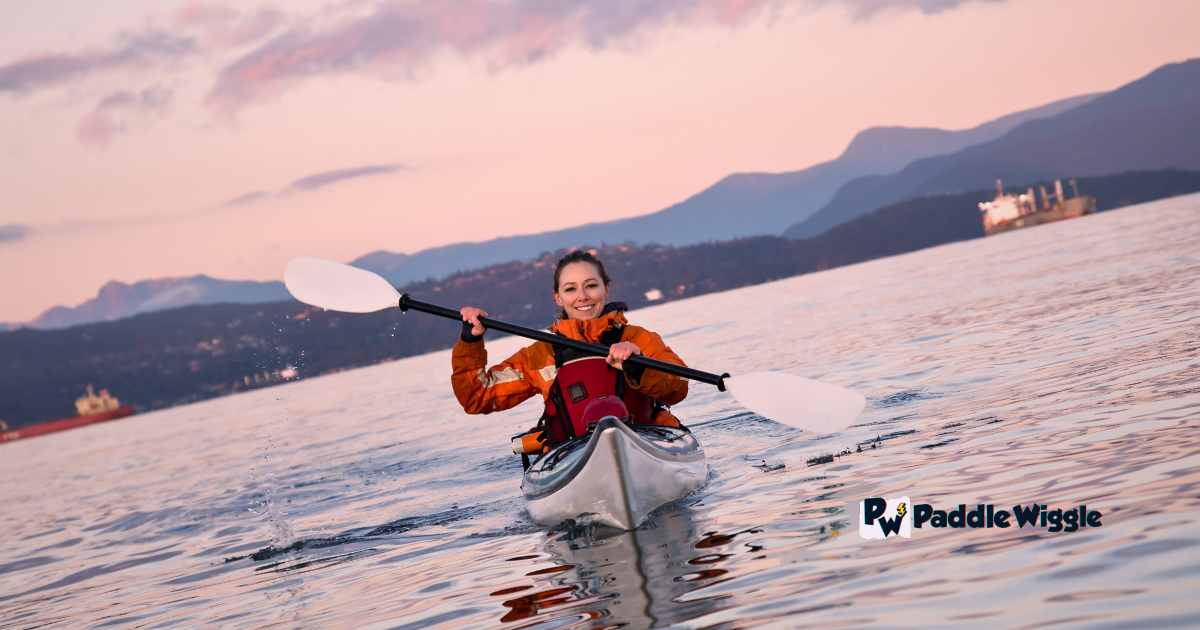

In contrast to row boats, kayaks are smaller in size with narrower hulls. This sleek design allows kayakers to move through the water with ease and navigate tight spaces effortlessly. Kayaks are highly maneuverable and agile on the water, making them ideal for activities like whitewater rafting or exploring narrow rivers.
Pros of Kayaks:
- Maneuverability: The narrow design allows kayakers to navigate through narrow channels and tight spots.
- Speed: Kayaks are generally faster than row boats due to their streamlined shape.
- Portability: Being lightweight makes it easier to transport kayaks from one location to another.
Cons of Kayaks:
- Stability: The narrow hull may make kayaks less stable in rough waters.
- Limited Space: Kayaks have limited space and may not be suitable for carrying large amounts of gear or passengers.
Choosing The Right Watercraft
When deciding between a row boat and a kayak, it’s important to consider your specific needs and preferences. If you prioritize stability, capacity, and versatility, a row boat might be the better choice. On the other hand, if maneuverability, speed, and portability are more important to you, then a kayak would be the way to go.
It’s also worth considering the type of activities you plan to engage in on the water. For fishing trips or leisurely cruises with family and friends, a row boat provides ample space for everyone and their belongings. However, if you’re looking for an adrenaline-pumping adventure like whitewater rafting or exploring narrow waterways, a kayak is better suited for those purposes.
Ultimately, both row boats and kayaks offer unique experiences on the water. Whether you prefer the stability of a row boat or the agility of a kayak depends on your personal preferences and intended use. So grab your oars or paddle and get ready to embark on your next aquatic adventure!
Design and Structure
Rowboats and kayaks may both be used for navigating bodies of water, but their design and structure differ significantly. Let’s take a closer look at these two vessels and how their unique features impact their performance in various environments.
Row Boats: Stability On The Water


Rowboats are known for their sturdy build and stability. They typically have a flat bottom with high sides, providing excellent stability in calm waters. This design allows rowers to maintain balance while using oars to propel the boat forward. The broad shape of row boats also provides ample space for storage, making them suitable for longer trips or carrying equipment.
Kayaks: Speed And Agility
On the other hand, kayaks boast a sleek and narrow design that prioritizes speed and agility in the water. Their streamlined shells allow them to glide swiftly through the waves, making them ideal for activities such as racing or exploring narrow waterways. Kayaks often require less power to maneuver due to their lightweight construction, allowing paddlers to navigate with ease.
Performance On Different Water Bodies
The differences in shape between row boats and kayaks greatly influence their performance on different types of water bodies. Rowboats excel in calm lakes or slow-moving rivers where stability is key. With their wide hulls, they provide a steady platform for fishing or leisurely cruising.
On the other hand, kayaks thrive in more dynamic environments such as fast-flowing rivers or even ocean waves. Their narrow profile allows them to cut through rough waters more efficiently, maintaining control even when faced with challenging conditions.
A Workout For Different Muscles
Both rowing a boat and paddling a kayak offer great physical exercise opportunities, but they engage different muscle groups. When rowing a boat, you primarily use your arms and upper body muscles to pull the oars through the water. This repetitive motion can help strengthen your biceps, triceps, shoulders, and back muscles.
Paddling a kayak, on the other hand, engages your core muscles as you rotate your torso to generate power. This activity not only works your arms and shoulders but also targets your abdominal and oblique muscles. Kayaking can provide an excellent full-body workout while enjoying the serenity of being on the water.
Similarities In Enjoying Nature
Despite their differences, row boats and kayaks share one common goal: allowing humans to connect with nature while exploring bodies of water. Whether you choose to row a boat or paddle a kayak, both vessels offer an immersive experience that allows you to appreciate the beauty of lakes, rivers, and oceans.
Purpose And Activities
Rowboats and kayaks are both popular watercraft used for various activities. While row boats are commonly used for fishing, leisurely cruising, or transportation, kayaks are more suitable for exploring narrow rivers, whitewater rafting, or ocean touring. Both provide opportunities for exercise and enjoying nature.
Row Boats: Fishing, Leisure, And Transportation
Rowboats have been around for centuries and are a versatile means of navigating the water. They come in various sizes and designs but typically feature a flat bottom with oars or paddles to propel them forward.
One of the main activities associated with row boats is fishing. Anglers often prefer row boats due to their stability and ample space to store fishing gear. Whether you’re casting your line in a calm lake or drifting along a riverbank, row boats offer a peaceful setting to reel in your catch.
Rowboats are also popular for leisurely cruising on calm waters. Imagine gliding across a serene lake on a sunny day, enjoying the gentle breeze as you soak up the scenery around you. It’s an excellent way to relax and unwind while connecting with nature.
Moreover, row boats can serve as an efficient mode of transportation on water bodies where motorized vessels may need to be allowed or practical. They can be used to reach islands or explore secluded coves that larger boats cannot access easily.
Kayaks: Adventure On The Water
Kayaks have gained immense popularity over the years due to their versatility and maneuverability. These sleek vessels sit low in the water and are propelled using double-bladed paddles.
One of the key activities associated with kayaking is exploring narrow rivers and creeks that may be inaccessible by other means of transport. Kayaks’ slim design allows them to navigate through tight spaces effortlessly, offering an up-close experience with nature’s beauty.
Kayaking is also popular among adrenaline seekers who enjoy whitewater rafting. These sturdy vessels can withstand the challenges of fast-flowing rivers and rapids, providing an exhilarating adventure for those seeking a thrill.
Furthermore, kayaks are well-suited for ocean touring. Whether you’re paddling along coastal cliffs or venturing further offshore, kayaking offers a unique perspective of marine life and stunning landscapes. It allows you to immerse yourself in the vastness of the ocean while enjoying tranquility away from the bustling shore.
Exercise And Enjoyment
Both row boats and kayaks provide opportunities for exercise and enjoyment in nature. The physical act of rowing or paddling engages various muscle groups, providing a low-impact cardiovascular workout. It’s a great way to improve strength, endurance, and overall fitness while enjoying the serenity of being on the water.
Both activities allow individuals to connect with nature on a deeper level. Whether it’s observing wildlife, admiring picturesque views, or simply relishing the peacefulness of being surrounded by water, rowing or kayaking offers an escape from daily routines and a chance to recharge in natural surroundings.
Types And Varieties
There are various types and varieties to choose from. Let’s take a closer look at the different options available for both row boats and kayaks.
Types Of Row Boats
Rowboats come in different designs, each with its own unique features. Here are some common types of row boats:
- Dories: These rowboats have a flat bottom and high sides, making them stable and suitable for fishing or leisurely rowing in calm waters.
- Skiffs: Skiffs are versatile row boats that can be used for fishing, transportation, or recreational purposes. They often have a shallow draft, allowing them to navigate in shallow waters.
- Wherries: Wherries are traditional row boats with long hulls and narrow beams. They are known for their speed and efficiency in the water.
Each type of rowboat has its own advantages and is suited for specific activities or preferences. For example, if you enjoy fishing, a dory or skiff may be the right choice due to their stability and spaciousness.
Varieties Of Kayaks


Kayaks also come in various styles, catering to different preferences and activities. Here are some common varieties of kayaks:
- Sit-on-Top Kayaks: These kayaks have an open cockpit design where you sit on top of the kayak instead of inside it. They are easy to enter and exit, making them popular for recreational use or warm-weather paddling.
- Sea Kayaks: Sea kayaks are designed specifically for ocean or open-water paddling. They have longer hulls for increased speed and stability in rough conditions.
- Recreational Kayaks: Recreational kayaks are versatile all-around kayaks suitable for calm lakes or slow-moving rivers. They offer stability and ease of use for beginners.
The type of kayak you choose depends on the environment you plan to paddle in and the activities you want to pursue. For instance, if you enjoy exploring lakes or calm rivers, a recreational kayak would be a good fit.
Variation In Techniques And Distances
Both row boats and kayaks offer different techniques for propulsion and maneuvering. Rowboats typically use oars or paddles to row through the water, while kayaks use a double-bladed paddle for forward motion.
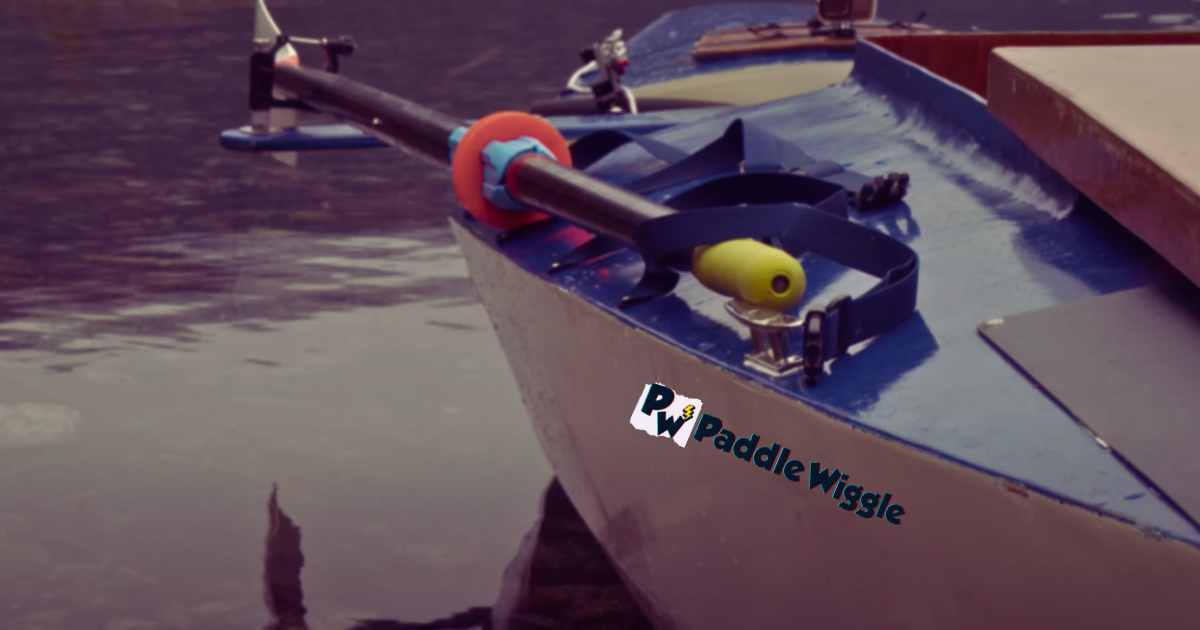

Rowboats and kayaks vary in terms of the distances they can cover. Rowboats are generally better suited for longer distances as they provide more power with each stroke. Kayaks, on the other hand, excel in agility and maneuverability, making them ideal for shorter trips or navigating narrow waterways.
Maneuverability And Control
Both rowboats and kayaks have their own strengths and weaknesses. Let’s take a closer look at how these two watercraft perform in terms of maneuverability and control.
Rowboats Offer Stability But Limited Maneuverability
Rowboats, with their larger size and wider beam, provide excellent stability on open waters. This stability makes them ideal for leisurely activities such as fishing or simply enjoying a calm day on the lake. However, due to their size and design, rowboats offer less maneuverability compared to kayaks.
Rowing a boat requires using oars that are attached to each side of the boat. By pulling the oars through the water in a synchronized motion, you can propel the boat forward or backward. While rowing provides decent control over the direction of the boat, kayaking may be more agile.
Kayaks Excel In Maneuverability
Kayaks are known for their high performance. With their slim design and lightweight construction, kayaks can easily navigate through narrow passages and tight corners. This makes them perfect for exploring rivers and streams or even tackling whitewater rapids.
Kayaking involves using a paddle with a blade on both ends. By alternating strokes on either side of the kayak, you can steer and propel yourself forward. The use of a single-bladed paddle allows for more precise movements and greater control over the kayak’s direction.
Choosing Between Control And Stability
The choice between a rowboat or kayak ultimately depends on your desired level of control versus stability needed for your water adventures. Here are some key considerations:
- If you prioritize stability over maneuverability: A rowboat might be your best bet if you prefer calm waters or plan to engage in activities that require more space, like fishing or picnicking.
- If you prioritize maneuverability over stability: A kayak is the way to go if you enjoy exploring narrow waterways, want to tackle challenging rapids, or simply want a more agile and responsive watercraft.
It’s important to note that while kayaks offer excellent maneuverability, they may need to be more stable in rough conditions compared to rowboats. This means that if you plan on venturing into choppy waters or facing strong currents, a rowboat might provide better stability and control.
Speed Differences: Kayaks Vs Rowboats
Kayaks and rowboats are both popular choices for recreational boating, but here are some noticeable differences between the two. Let’s take a closer look at how kayaks and rowboats compare in terms of their speed on the water.
Kayaks: Streamlined Design And Efficiency
Kayaks are known for their sleek and streamlined design, which allows them to glide through the water with ease. The narrow hull and pointed bow of a kayak help to reduce drag and resistance, enabling it to move swiftly through the water. This efficient design makes kayaks generally faster than rowboats.
Rowboats: Power Versus Resistance
Rowboats, on the other hand, offer more power due to their larger size and ability to accommodate multiple rowers. With each rower contributing their strength, rowboats can generate significant propulsion in the water.
However, this increased power is offset by the boat’s larger size and greater resistance in the water.
Factors Affecting Speed
While kayaks are generally faster than rowboats, it’s important to note that speed can vary depending on several factors:
- Technique: Both kayaking and rowing require proper technique to maximize speed. Skilled kayakers or rowers who have mastered efficient paddling or rowing techniques will be able to achieve higher speeds compared to beginners.
- Skill Level: Experience plays a crucial role in determining speed on the water. Experienced kayakers or rowers who have honed their skills over time will have better control over their boats, allowing them to navigate more efficiently and increase their overall speed.
- Boat Models: The specific design of a kayak or rowboat can also impact its speed capabilities. Different models may have varying features that affect performance, such as hull shape, weight distribution, or materials used in construction.
Evaluating The Differences Between Rowing And Kayaking
Rowing and kayaking are two popular water activities that offer different experiences. Let’s take a closer look at the key differences between rowing and kayaking.
| Aspect | Rowing | Kayaking |
|---|---|---|
| Watercraft Type | Typically involves rowboats with oars. | Involves kayaks with paddles. |
| Seating | Seated facing backward, away from the direction of movement. | Seated facing forward, in the direction of travel. |
| Paddle Type | Uses long oars to propel the boat forward. | Uses a double-bladed paddle to propel the kayak forward. |
| Hull Shape | Broad, flat hull for stability. | Narrow, sleek hull for agility. |
| Activities | Commonly used for leisure rowing, fishing, and transportation. | Suitable for kayaking, touring, fishing, and whitewater paddling. |
| Maneuverability | Typically less agile, with a larger turning radius. | Highly maneuverable, easy to navigate through tight spaces. |
| Stability | Generally stable but can be affected by waves and currents. | Known for good stability, especially in calm waters. |
| Skill Level | Requires coordination and technique in rowing. | Accessible to beginners, but offers room for skill advancement. |
| Transportation | Often requires trailers and larger storage space. | Easy to transport on car roof racks, lightweight and compact. |
| Storage | Takes up more storage space due to size. | Requires less storage space, ideal for small spaces. |
| Maintenance | May involve oar maintenance and hull care. | Minimal maintenance, simpler construction. |
| Costs | Costs vary, including boat, oars, and maintenance expenses. | Generally more affordable, with fewer additional costs. |
| Teamwork | Typically done in larger boats with multiple rowers. | Typically done in smaller boats with one or two kayakers. |
| Movements | Requires synchronized movements and teamwork. | Requires individual paddling skills. |
| Competitive Aspect | Primarily a competitive sport. | Can be both a recreational activity and a competitive sport. |
| Water Environments | Often performed in rivers, lakes, or the ocean. | Can be performed in various bodies of water, including rivers, lakes, and the ocean. |
| Seating Arrangement | Involves a sliding seat and foot straps for stability. | Involves sitting in a closed cockpit with a spray skirt for stability. |
| Paddling Technique | Focuses on long, continuous strokes for speed and endurance. | Focuses on shorter, more powerful strokes for maneuverability. |
| Direction | Rowers face backward while rowing. | Kayakers face forward while paddling. |
| Olympic Sport | Rowing is an Olympic sport with various events. | Kayaking is an Olympic sport with various events. |
| Physical Demands | Rowing can be more physically demanding. | Kayaking can be more technically challenging in terms of maneuvering. |
Coordinated Movements Vs Solo Or Partnered Experience
Rowing requires coordinated movements from multiple rowers working together in sync to propel the boat forward. It’s like being part of a team, where everyone has to paddle in harmony to achieve a common goal.
On the other hand, kayaking can be done solo or with a partner. You have complete control over your kayak and can navigate through the water at your own pace. It allows for more independence and flexibility in choosing your route.
Team-Oriented Vs Individual Control
Rowing is a team-oriented activity that fosters cooperation and communication among the rowers. Each person has a specific role and must work together seamlessly to move the boat efficiently.
It requires good teamwork and coordination to achieve success on the water. In contrast, kayaking offers individual control over your own vessel.
You can make decisions on your own without relying on others’ input or actions. It provides a sense of freedom and personal accomplishment as you navigate through the water independently.
Personal Preferences And Social Interaction
The choice between rowing and kayaking ultimately comes down to personal preferences and desired social interaction. If you enjoy being part of a team, working together towards a common goal, and engaging in constant communication with fellow rowers, then rowing might be an ideal choice for you. It allows for social bonding, camaraderie, and shared experiences with others who share your passion for rowing.
On the other hand, if you prefer solitude or want to spend quality time with just one partner while enjoying nature’s beauty in calm waters, then kayaking might be more suitable for you. It offers tranquility, peacefulness, and opportunities for self-reflection as you paddle through serene surroundings.
Learn More
Can I Use A Row Boat For Fishing?
Yes! Rowboats are great for fishing due to their stability and spaciousness. You can easily cast your line without worrying about tipping over.
Can I Use A Kayak In Rough Waters?
Yes, certain types of kayaks are designed specifically for rough waters like rivers or oceans. These kayaks have enhanced stability and durability features that allow them to handle challenging conditions.
Final Words
Finally, if you’re seeking a more leisurely experience with the ability to bring along friends or family, a rowboat may be your best bet. Rowboats provide stability and ample space for activities like fishing or picnicking. On the other hand, if you crave adventure and want to explore narrow waterways or tackle rapids, a kayak is an excellent choice. So, which adventure do you prefer?

